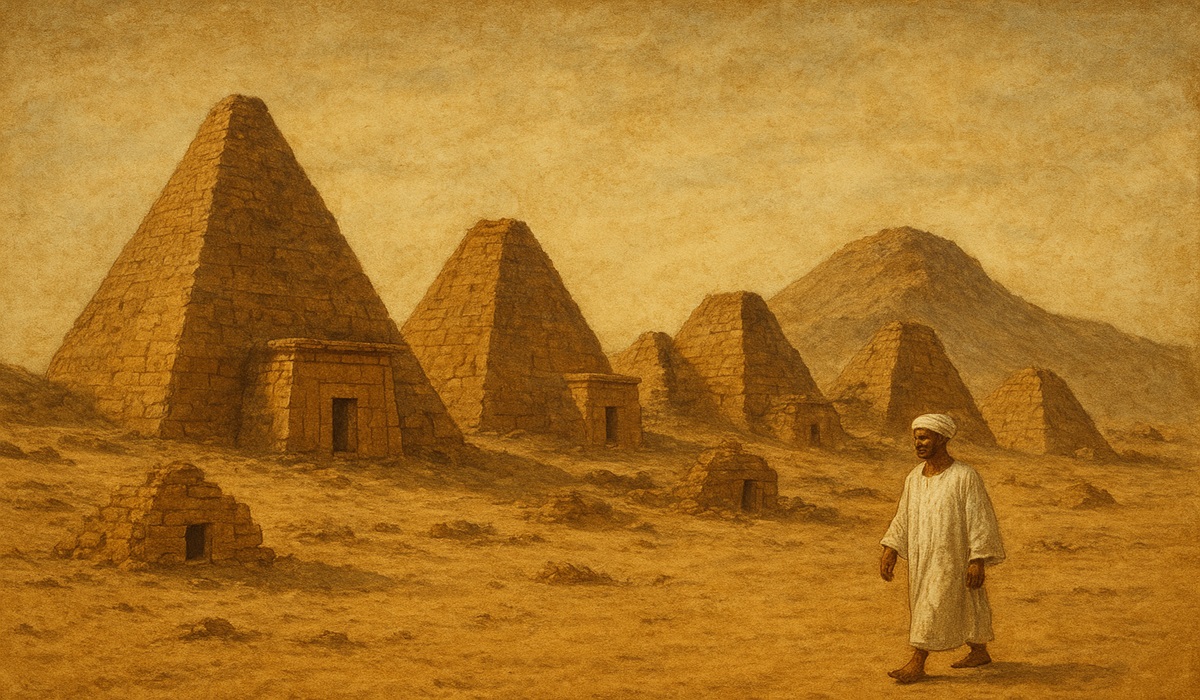Sudan: The Forgotten Land of Pyramids and Ancient Civilizations
- TDS News
- Africa
- Trending News
- September 4, 2025

By Donovan Martin Sr, Editor in Chief
When most people think of pyramids, their minds immediately drift to Egypt—the towering monuments of Giza, the Sphinx standing guard, and the desert sands carrying millennia of stories. Yet, farther south along the Nile lies Sudan, formerly known as Nubia, home to a civilization equally ancient and, in some ways, even more pyramid-rich than its northern neighbour. Sudan’s history is one of grandeur, resilience, and overlooked glory. With more than 200 pyramids still standing, Sudan surpasses Egypt in sheer number, a testament to its role as a cradle of African civilization.
To understand Sudan’s importance, one must begin by setting aside the Eurocentric lens through which African history has long been told. For centuries, European mapmakers and chroniclers presented Africa as a continent existing only in relation to Europe—often marginalized, distorted, or outright erased. In fact, many early European maps flipped Africa upside down or compressed it unnaturally, reinforcing the idea that Africa was a land of mystery, secondary to the so-called “Old World.” Yet history tells us otherwise: Africa, particularly the Nile Valley, was the epicenter of civilization long before the rise of Greece, Rome, or Europe’s so-called “Renaissance.”
The land we now call Sudan was once Nubia, stretching across the fertile banks of the Nile south of Aswan. Rich in gold, ebony, ivory, and cattle, Nubia became a center of wealth and power as early as 3500 BCE. Its strategic location connected Sub-Saharan Africa with Egypt and the Mediterranean, turning Nubia into a crossroads of culture and commerce. The ancient Egyptians themselves referred to Nubia as Ta-Seti, the “Land of the Bow,” a nod to the Nubians’ unmatched skill as archers. Nubian mercenaries fought in Egyptian armies, Nubian traders supplied Egypt with precious goods, and Nubian rulers eventually carved out their own dynasties that rivaled, and at times ruled over, Egypt itself.
This period culminated in the rise of the Kingdom of Kush, centered at Napata and later at Meroë. Around 747 BCE, Nubian kings conquered Egypt, establishing the 25th Dynasty, often called the dynasty of the “Black Pharaohs.” Kings like Piye and Taharqa not only united Egypt and Nubia but also launched campaigns into the Near East, clashing with the mighty Assyrians. Taharqa, in particular, left a mark as both a warrior and a builder, erecting temples and monuments that still stand. The Kushite dynasty was eventually pushed out of Egypt, but Nubia remained an independent and powerful kingdom for nearly a thousand years thereafter. Its capital at Meroë became a hub of iron production, trade, and learning, earning it the title of the “Birmingham of Africa” among modern historians.
If Egypt is famed for its colossal pyramids at Giza, Sudan boasts a staggering number of smaller yet equally significant pyramids scattered across sites like El-Kurru, Nuri, and Meroë. Built between 800 BCE and 300 CE, these pyramids served as royal tombs for Kushite kings and queens. Unlike the broad-based pyramids of Egypt, Nubian pyramids are distinguished by their steep angles and narrower bases, often rising dramatically from the desert floor. Many are adorned with chapels and carved reliefs depicting rulers and deities, blending Egyptian religious motifs with uniquely Nubian styles. There are over 200 pyramids in Sudan, compared to Egypt’s approximately 118. Yet while Egypt’s pyramids have become icons of global heritage, Sudan’s pyramids are less visited and less studied, partly due to colonial neglect and modern instability. The irony is striking: the land with the most pyramids in the world lies overlooked, its treasures buried in obscurity.
Sudan’s legacy cannot be separated from the broader story of Africa’s role in human civilization. For thousands of years, Africa was not a “dark continent” but the radiant center of knowledge, trade, and innovation. Long before the rise of Athens or Rome, Nubia and Egypt developed writing systems, advanced architecture, and state institutions. The Nile Valley was home to astronomy, medicine, mathematics, and religious traditions that influenced later cultures around the world. The ancient Greeks themselves acknowledged this debt. Herodotus, the “father of history,” described Egypt as “the gift of the Nile” and recounted journeys into Nubia, remarking on its wealth and antiquity. Many Greek philosophers studied in Egypt, drawing from African traditions of learning. In essence, what Europe later called its “classical civilization” was built upon African foundations.
Part of the reason why Nubia and Sudan’s contributions have been obscured lies in how Africa has been represented. European mapmakers from the 15th century onward often depicted Africa inaccurately, shrinking it, flipping its orientation, or exaggerating Europe’s position. This was not mere cartographic error but a deliberate act of intellectual colonialism: by diminishing Africa’s size and centrality, Europeans reinforced the idea of African inferiority. In truth, Africa is massive—the second-largest continent, larger than the U.S., China, India, and much of Europe combined. Its rivers, deserts, and kingdoms shaped global history. Yet maps served as psychological tools of empire, erasing the memory of Africa’s primacy in human civilization. Sudan, with its pyramids and pharaonic legacies, is perhaps the clearest example of this erasure. Where European narratives emphasized Egypt as part of a “Mediterranean world,” they often severed Egypt from its African roots, downplaying the Nubian and Sudanese contributions. The reality is that the civilizations of Egypt and Nubia were two sides of the same African coin.
The Kingdom of Kush eventually declined by the 4th century CE, pressured by shifting trade routes and invasions. Yet Sudan did not disappear into history. Christian kingdoms like Nobatia, Makuria, and Alodia flourished in the medieval period, building cathedrals and maintaining diplomatic relations with Byzantium. Later, with the spread of Islam, Sudan became part of the broader Islamic world, while still retaining its distinct identity. Today, the pyramids of Meroë stand in the desert as silent witnesses to a once-great civilization. They remind us that Africa’s history is not peripheral but central to the story of humanity.
In recent years, archaeologists and historians have begun to restore Sudan’s rightful place in world history. Excavations at Meroë, advances in Nubian studies, and growing awareness of Africa’s ancient contributions are rewriting the narrative. Scholars argue that to truly understand civilization, one must begin not in Greece or Rome, but in the Nile Valley—stretching from Egypt to Sudan. Sudan’s pyramids tell us that Africa was once at the very top of the known world: a continent that produced kings, queens, builders, scholars, and warriors whose influence spread far beyond their borders. Before Europe emerged from its own “dark ages,” Africa was already a land of light.
Sudan is more than an archaeological site; it is a living reminder that the story of civilization cannot be told without Africa at its center. Its pyramids rise not just from sand but from memory, asking the world to look south of Egypt and see where history’s foundation was truly laid.








